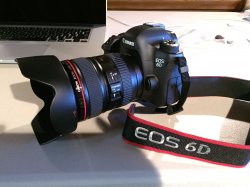You should definitely look into other brands if you're not locked into one system or another, and you should ignore fanboys from either side to convince them that their system is the right one. In the end, it's about photos.I'm not married to Canon, I do not own lenses. I learned on a T3i but bottlenecked with high ISO/low light shots.
The proven name the 6D has given itself as a economically reasonably way into a FF camera with good high ISO ability. It's reputation is what has me hot on its trail....
I am aware of it's lack of AF technology compared to other DSLR's. Although not specifics.
It seems to me you're focussing too much on the body and too little on the lenses. Coupled to the right lens, your current camera can beat the pants off a full frame body with a mediocre lens and this isn't hyperbole. So when you switch to full frame, you should know that you should invest at least the cost of the body into lenses. Full frame lenses are more expensive and heavier than their crop sensor counter parts. So the kit lenses you have in mind they're not bad, but at f/4 they're slow and they're not great. Initially, you could supplement your f/4 kit zoom with one or two fast primes (e. g. Sigma's new 50 mm f/1.4 or 85 mm f/1.4 lenses which are optically and mechanically excellent). Especially if you are interested in low light photography, f/4 is not going to cut it.
Plenty of people have given you advice on Canon's FF line-up, so I won't repeat what they've said. They're good cameras, but Canon has been lagging a little behind Sony/Nikon in the sensor department (most sensors Nikon uses are built by Sony). Don't worry, these differences show only when you push these cameras to their limits, and they don't prevent you to take great pictures either way. But it's still something to be aware of.
Nikon makes three semiprofessional FF cameras (I omit the D810 and the D4s):
- Nikon D610 (entry-level)
- Nikon Df
- Nikon D750
All of them come with a professional-level AF and lens-wise Canon and Nikon are neck-and-neck (if you are talking about specific lenses, there are cases where one is better than the other, but I don't think there is a clear trend that one manufacturer is better than the other). Probably the Nikon D610 is best in view of your budget. The Df is a bit of an odd duckling, apart from the design and the retro user interface, I don't get how it is supposed to slot into the line-up. The D750 is brand new and takes many features of the bigger D810, and marries them to a lower resolution sensor (24 MP instead of 36 MP).
Sony also makes FF mirrorless cameras, the A7 and A7R. Personally, I don't like the concept of Sony's mirrorless cameras (I'm in the process of a conversion from Nikon to Fuji), but you can't argue about image quality. They use the same sensors as the Nikons, and differences due to differences in image processing are small. They also have first-class lenses. Not only the body, but also lenses for mirrorless cameras are smaller (a consequence of the laws of physics
My advice to you is to focus less on the body and more on lenses. If you are expecting significant improvements by coupling a best-of-breed body to a mediocre lens, you'll be disappointed. Lenses last much, much longer than bodies and anyone who is serious about photography has invested more money into lenses and other accessories than the body. Also, don't underestimate the weight and size of full frame equipment, compared to your T3i the weight of body + lens can easily triple! Moreover, you'll definitely need at least three more essential accessories:
- a good camera bag
- a good camera strap
- one or two protective wraps: they are very cheap and they allow you to put your camera safely into, say, a backpack when you go out for a quick hike.



